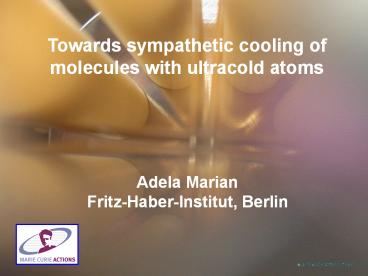Towards sympathetic cooling of molecules with ultracold atoms
1 / 22
Title: Towards sympathetic cooling of molecules with ultracold atoms
1
Towards sympathetic cooling of molecules with
ultracold atoms
Adela Marian Fritz-Haber-Institut, Berlin
2
Outline
- Introduction
- Slowing molecules using a wire
- Stark decelerator
- AC electric trapping of rubidium atoms
- Idea
- First results
- Outlook
3
Sympathetic cooling of molecules by ultracold
atoms
Requirements
?
- The molecules need to be trapped in their
lowest-energy quantum state. - The trapped clouds of atoms and molecules need
to be spatially overlapped. - The atom and molecule traps should not perturb
each other.
?
?
Our approach
4
Principle of Stark deceleration
HV
LFS Molecule enters E-field
LFS Molecule exits E-field
-HV
5
Principle of Stark deceleration
time 1
synchronous molecule flying through an array of
deceleration stages
kinetic energy loss at each stage
time 2
H. L. Bethlem et al., PRL 83, 1558 (1999)
6
Most efficient Stark decelerator
- 85 cm long
- need 3 modules for best decelerated signal
L. Scharfenberg et al., PRA 79, 023401 (2009)
7
Combining atom and molecule machines
- very different vacuum requirements
- molecules 10-8 mbar
- atoms 10-10 mbar
- spatial constraints
OR use special extension
use best big decelerator
- high-density beams
- too far away
- close to atom trap
- technically very difficult
8
Idea mini-decelerator
101 compared to one of the big machines
6 mm electrodes 4 mm x 4 mm gap 20 000 V
applied voltage 1111 mm length 100 stages
gt 0.6 mm electrodes gt 0.4 mm x 0.4 mm gap gt
2000 V applied voltage gt 111 mm length gt 100
stages
Solution use Ø0.6 mm Ta wire
9
Comparison with the big decelerators
Advantages
- short decelerator
- compact vacuum system
- good for short-lived molecules
- bakeable
- lower costs
- smaller vacuum chamber(s)
- smaller pumps
- cheap electrodes
- lower voltage supplies and switches
10
Comparison with the big decelerators
Disadvantages
- very small gap gt less molecules accepted
- gt construction
precision
- possible to obtain 0.01 mm accuracy!
11
Experimental setup
12
Recent data Deceleration of 13CO
2.0
1.5
- mean beam velocity 500 m/s
- pressure in decelerator chamber
- (with gas load) 6 x 10-9 mbar
Intensity (arb. units)
1.0
- applied voltage 2 kV
- decelerated peak 450 m/s
0.5
0.0
1.2
1.1
1.0
0.9
0.8
0.7
0.6
Time of flight (ms)
13
Recent data Deceleration of 13CO
3 kV applied voltage!
14
Conclusion Outlook
We have decelerated CO molecules using a wire
decelerator.
- bake out decelerator 1st UHV-compatible
decelerator - condition to even higher voltages
- use a cooled valve to reduce initial velocities
Next steps
- Collisions experiments with trapped atoms
15
Flying through the decelerator(A molecule's view)
Courtesy of Henrik Haak
16
Thanks
Gerard Meijer Henrik Haak Peter Geng Sam Meek Bas
van de Meerakker
Thank you for your attention!
17
Operation principle of an AC electric trap
A saddle point is created for the electric field
which can be rapidly switched around
J. van Veldhoven et al., PRL 94, 083001 (2005)
18
Electric fields in the trap
z
r
r focusing
z focusing
19
Frequency scan
x 10 5
2.5
Expt
Theory
2.0
1.5
Number of atoms
1.0
0.5
0.0
75
70
65
60
55
50
Switching frequency (Hz)
- Taken after a trapping time of 5 s
- Frequency range agrees with trajectory
calculations - 2.5 x 105 atoms _at_ 61 Hz
20
Dynamic confinement of the atoms
(a)
(c)
(b)
g
(e)
(d)
0.25
z
Optical density
r
0
focusing
r
- Pictures taken at a switching
- frequency of 60 Hz after 1 s
- of trapping
- Switching cycle asymmetric
- with 59 r focusing
- Excellent agreement with
- trajectory calculations
c
a
b
d
e
z focusing
T16.7 ms
Time
S. Schlunk et al., PRL 98, 223002 (2007)
21
Mapping of the electric fields
22
Acknowlegdment
Sophie Schlunk Wieland Schöllkopf Peter
Geng Amudha Duraisamy Gerard Meijer
Thank you for your attention!































